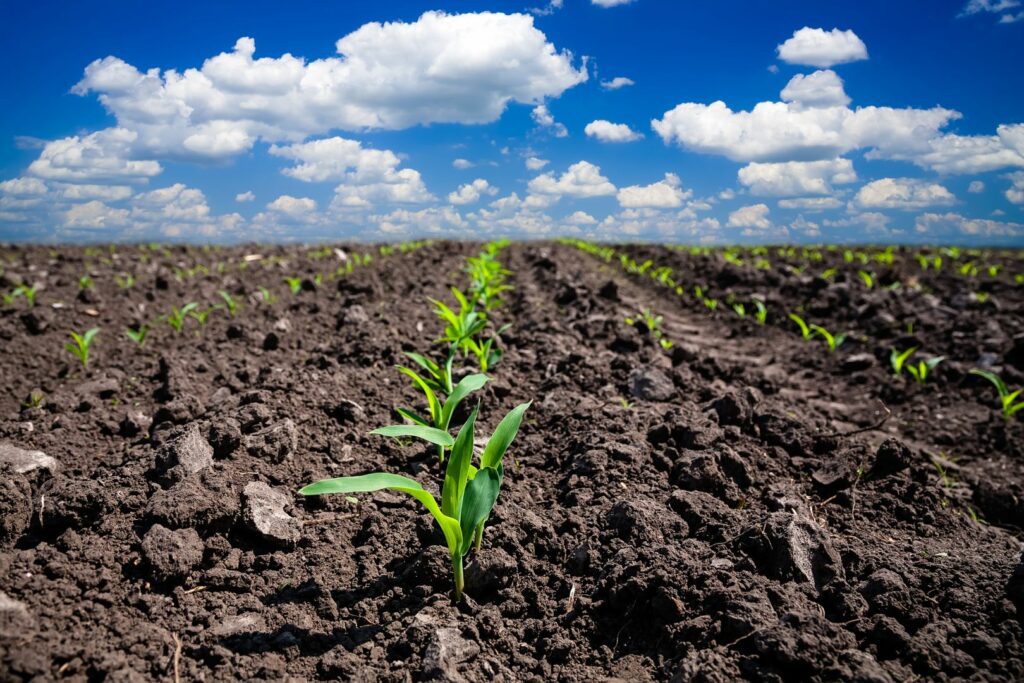You never want your crop to have a bad day, said Alan Kauffman, Ohio-based Midwestern BioAg sales consultant. “Marathon runners don’t skip breakfast the day of a big race. That’s why we put down starter fertilizer in the spring — to get those plants off to a strong start.”
Midwestern BioAg scientist Bill Petersen agrees. “Our 2015 studies with Dr. Fred Below of the University of Illinois looked at early-season advantages of starter application. In the study, we added L-CBF BOOST™ and 10-34-0 to corn. Advantages of applying starter fertilizer were measurable and visually obvious,” noted Petersen. “I think Dr. Below says it best: Start strong, stay strong, finish strong.”
Years of research support Dr. Below’s findings that applying starters in the seedling and early vegetative stage of development encourages strong starts. “It’s well documented that if you have two plants side by side and one plant is one or two leaf stages behind the other, the plant left behind never catches up,” said Kauffman. “There’s no way to finish strong if you don’t start strong.”
Improving Early Season Uptake
Plant starter fertilizer ensures new seedlings have access to ample nutrients early in the season. “This is especially important in cool soils,” said Kauffman. In early spring, soil biological activity and nutrient availability is limited. “Even in high-testing soils, early season nutrient availability may be lower than expected. When roots are in the early development stages, they can’t reach the nutrients they need. Starter helps bridge this gap.”
“I recommend ammonium sulfate as a nitrogen source in dry starters for two main reasons,” said Kauffman. “When the ammonium form of nitrogen is used, it acidifies soil around the seed bed and increases phosphorous uptake. It also provides sulfate sulfur, which supports plant growth and health.”
Because starters are placed near the seed, fertilizer quality must be closely evaluated to reduce chances of plant damage. “Starters with high salt indexes can harm early root growth and reduce nutrient uptake. At Midwestern BioAg, our blends swap out commercial-grade nutrients for high-quality ingredients.”
As the salt index of fertilizer increases, the potential for seed injury also increases. “Growers on dry or sandy soils must be especially careful,” said Kauffman. “The likelihood of injury from salts increases on that type of ground.”
Balance, Concentration & Recovery
Starter fertilizers are designed to support early season growth, but not necessarily season-long performance. “In the big picture, applying basic starter fertilizer is not a season-long fertility plan,” said Kauffman. “It’s giving plants the best opportunity at a good start. The V5 to V8 growth stage for corn and beans is very important. Development during these stages directly impacts yield.”
Kauffman recommends applying dry fertilizer before or at planting. “We want to put down a balanced fertilizer blend that contains soluble and slow-release nutrients. This is when we can address yield-limiting factors like calcium and sulfur deficiencies. We can address nutrient deficiencies with dry starters, but have fewer options with liquid products.”
“I’d like to apply both a liquid pop-up and a dry starter at planting, but most farms do not have that capability,” said Kauffman. “For most customers, I recommend bulk-spreading dry fertilizer followed by L-CBF at planting. Nutrients are more soluble in liquid, which is ideal for young roots.”
Midwestern BioAg’s high-quality fertilizer ingredients give producers more flexibility at planting. Because ingredients are non-harmful to young plants, growers can go beyond a basic starter and put down a complete, balanced fertilizer without fear of plant burn. This gives farmers all the benefits of a starter fertilizer in the spring, in addition to the season-long benefits of a balanced Midwestern BioAg blend.
“We can recommend a blend to support early season growth, as well as season-long performance. With the right planter set up, this can eliminate an extra pass on the field, and help reduce compaction overall,” said Kauffman.
Next Steps
In addition to early season growth, starter fertilizers provide many season-long benefits. These include quicker canopy cover, lower moisture at harvest (for corn), less weed competition and reduced soil evaporation. “For my organic producers, this is essential,” said Kauffman. “Early canopy can help shade out weeds. If the weeds are as tall as or taller than the crop, you’ve already lost the battle if you can’t use chemicals.”
Kauffman recommends closely monitoring nitrogen as the season progresses. “Split application of nitrogen is ideal,” said Kauffman. “I recommend ESN® in pre-plant applications for season-long availability, followed by L-CBF mixed with 28% or 32% as a side-dress for early season support.”
Starters provide many season-long benefits, including quicker canopy cover, lower moisture at harvest (for corn), less weed competition and reduced soil evaporation.
Because corn needs three times as much nitrogen after the V10 stage, access to late-season nitrogen is essential to support yield. “It does not take a lot of nitrogen to get things going,” said Kauffman, “but running out of nitrogen in later growth stages can lead to big yield losses.”
Finishing Strong
“The biggest factor affecting crop production is weather,” said Kauffman. “In a severe drought, there’s not a lot a grower can do to prevent yield loss. But there are a few things they can do to help keep losses to a minimum.”
By focusing on soil health, growers can improve soil water- and nutrient-holding capacity. “A good soil structure can improve plant resistance to stress factors like weather extremes and disease pressure,” said Kauffman. “Products like Bio-Cal® provide calcium to open up soil structure and help create humus — this improves soil drainage and water-holding capacity, and also helps unlock nutrients in the soil.” Improvements to structure can also increase rooting potential.
“All Midwestern BioAg products have one thing in common,” said Kauffman. “They build soil health in the long-term while supporting crop production in the short-term. If you want to give your plants a head start this season, we can help.”

